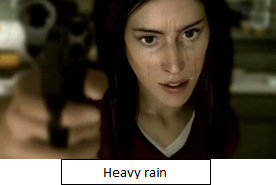Photo realisim
Video games usually have a distinctive style of their own however they can all be categorised into one of the four main categories that are Photorealism, cel-shading, abstraction and exaggeration.
Photorealism is something which you will see in a lot of today’s game, and it is getting more and more popular and advanced as our games evolve with the technology. Just a few years ago we might’ve considered games such as Zoo Tycoon and Lara Croft to be realistic, where surfaces are painted as flat textures onto large polygons. Of course, the computers in modern day can now handle much more and so the graphics have been able to become more detailed; so detailed in fact they can almost be considered as convincing as photographs.. We have also uncovered new ways to create the light and shadow; now using a 3 point bounce system where we previously used only a 2 point bounce system. Because of this we now have games such as Heavy rain, Fifa, Pgr4 etc..
It’s much easier to render an object such as a car or another object realistically, as it’s movement and shapes are generally much simpler- with, for example a human face, the sheer complexity of the muscles involved make making this realistic very challenging. Rendering realistic still images isn’t such so beyond us now.. But the difficulty comes when animating- as we need both the artistic skills and a thorough knowledge of the anatomy involved.
New technologies are new being discovered, in which the intricate details of a person’s muscles and miniscule movements are tracked and recorded in a 360 degree video, making reproducing these movements in an virtual sculpt from varying angles a much more reconcilable task, with more believable results.
Images:
http://n4g.com/news/65901/new-pgr4-screenshots
http://www.joystiq.com/2007/11/21/quantic-dream-buys-cutting-edge-motion-capturing-tech/
http://z15.invisionfree.com/ZT2_Spanish_Dev/index.php?showtopic=500http://n4g.com/news/65901/new-pgr4-screenshots
http://www.joystiq.com/2007/11/21/quantic-dream-buys-cutting-edge-motion-capturing-tech/
Information:
http://www.gamasutra.com/blogs/AleksanderAdamkiewicz/20121021/179846/Photorealism_In_Video_Games__A_Worthy_Goal.php
http://arstechnica.com/gaming/2012/02/how-close-are-we-to-truly-photorealistic-real-time-games/
http://www.gamasutra.com/blogs/AleksanderAdamkiewicz/20121021/179846/Photorealism_In_Video_Games__A_Worthy_Goal.php
http://arstechnica.com/gaming/2012/02/how-close-are-we-to-truly-photorealistic-real-time-games/
Cel-shading
(A basic example of how cel-shaded graphcs are rendered.)
Cel-shading is a artistic style more commenly seen in graphic novels and comics. It's usually used to portray a more cartoonish look, by blocking in very distinctivly where the light would hit and the shadows would cast. As the name suggests, cel-shading is made up of cell-like segments of highlights and dark tones- asthough these segements can be both solid or soft shaded.
A good example of the cel-shading artistic style can be seen at the online graphic novel http://off-white.eu/.
Due to it's cartoonish, oten clip-art apperence, cel-shading can often look like vector art, and often is.
Cel-shading is not only used in comics, but also in games, both 2D and 3D. It's a very efficient way of shading in 3D, especially for rigid shapes with polygon rendering. Due to the simplicity of this type of shading in terms of a more limited colour palate, it requires less memory and so is not difficult for a game to render. This makes it a very efficient choice for reducing it's lag, over some, more complex techniques such as realistic. It is also cheaper to produce.
In order to render objects in real time, with cel-shading, the computer must use an algorithmic formula to calculate the values of colour according to depth, light and perspective. This is similar to any normal way of rendering apart from that the outcome needs to be much more blocked in and have a much more limited range of colours. It is especially important in 3D rendering as the colours or shades need to be smooth in terms of transition and not flickering.
(Above: My own cel-shading attempt)
In 2000, 'Jet set radio' for Sega was released; the first cel-shaded, interactive media product. We now have many other titles that use cel-shading as it's main artist style. This includes things such as 'The simpsons' (2007), and the much more recent 'Ni no kuni' (2013).
Information:
http://en.wikipedia.org/wiki/List_of_cel-shaded_video_games
http://www.giantbomb.com/cel-shading/3015-173/
http://en.wikipedia.org/wiki/List_of_cel-shaded_video_games
http://www.giantbomb.com/cel-shading/3015-173/
Abstraction
Abstraction is an artistic style found mainly in games such as 'Tetris' and 'Osmos'. It involves geometric shapes and exaggerated colours, and does not attempt to be anything realistic. It does not usually pertrain to belong to a storyline and usually has no characters, relying heavily on it's playablity as a game.
It's a very specific art style that would not suit most genres, but is perfect for others; particuarlly ones that aim to put most of the focus on physics or logic puzzles, as another art style such as realistic, cel-shaded or exaggerated might well distract from this.
Other abstract games include 'Anti-chamber', 'Colourblind' and 'SuperHegagon'. As the style is oftentimes simple, and computer generated (thus not reliant on an expensive art budget), games with this style are oftentimes indie development projects.
Imageshttps://blogger.googleusercontent.com/img/b/R29vZ2xl/AVvXsEhumzUqqR5Qny6xmQeXp0-TI4AVLWyAqnYEtzrtH8CJSLF4T7GuPnihK6_A6dklokyMcd05QqbMX29bVyNGftqa6LH7JJYNQ4Tv1IanwIQWbgBhFhsfoF-YGNqRODJNpNaUniNMPiWet13B/s400/tetris.gif
Info
http://www.giantbomb.com/abstract-art-style/3015-1558/
http://www.quora.com/Video-Games/What-are-some-examples-of-abstract-video-games
http://www.boardability.com/game.php?id=abstract_games
http://www.giantbomb.com/abstract-art-style/3015-1558/games/
Exaggeration
Exaggeration is something found in most game these days- whether that be in the violence, disproportionate figures or scenery, or expressions. The kinds of games that use this style usually have an element of realism about them, but features have been exaggerated or obscured to give it a less serious feel. It's often used in children's games, anime and wii games because it can help to make it feel more friendly and 'fun'.
The style isn't limited to this however, it's also heavily used in what you might consider 'realistic' games in order to enhance and exaggerate the violence. Characters are often changed in design so that they have larger shoulders or arms to appear unrealistically strong. This is quite an arty style, unrealistic, but often with realistic texturing giving it quite a nice feel.
'Rayman Raving Rabbids' and 'Zelda' are good examples of exaggeration.
(Zelda: Combat is heavily exaggerated, using strange colours and lights to enphisize the strike of a sword.)
(Rayman Raving Rabbids: You can see just from looking how the character's appearence is exaggerated here. From proportions, to expressions.)
Images
Info







No comments:
Post a Comment